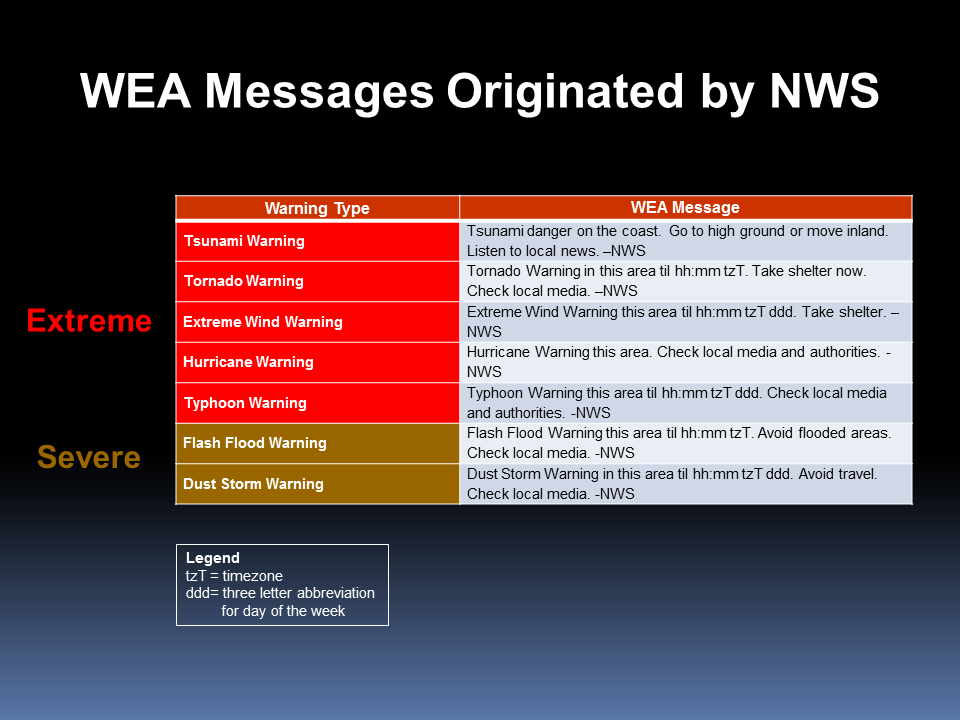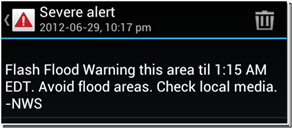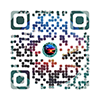WIRELESS EMERGENCY ALERTS (WEA) |
 Imagine this: You're driving down the highway, humming along to your favorite tunes, when your cell phone stowed in the console or purse etc. suddenly
makes a strange noise. To investigate, you take the next exit and safely pull over to check the screen. Good thing you did: Your phone just alerted
you to a tornado a few miles away in same county you're driving through.
Imagine this: You're driving down the highway, humming along to your favorite tunes, when your cell phone stowed in the console or purse etc. suddenly
makes a strange noise. To investigate, you take the next exit and safely pull over to check the screen. Good thing you did: Your phone just alerted
you to a tornado a few miles away in same county you're driving through.Sound plausible? It is and it is currently implemented and active in many areas. America’s wireless industry is helping to build a Weather-Ready Nation through a nationwide text emergency alert system, called Wireless Emergency Alerts (WEA).
- FREQUENTLY ASKED QUESTIONS -
- What are WEA messages?
- Wireless Emergency Alert (WEA) messages are emergency messages sent by authorized government alerting authorities through your
mobile carrier. Government partners include local and state public safety agencies, FEMA, the FCC, the Department of Homeland Security,
and the National Weather Service.
No sign-up is required! Alerts are sent automatically to WEA-capable phones automatically during an emergency.
Alerts are sent using radio technology broadcasted from cell towers. Only alerts relevant to the tower(s) you are near at the time are received, even if you are out of state traveling, so long as your cell phone is receiving a cell signal.
- Wireless Emergency Alert (WEA) messages are emergency messages sent by authorized government alerting authorities through your
mobile carrier. Government partners include local and state public safety agencies, FEMA, the FCC, the Department of Homeland Security,
and the National Weather Service.
- Why is this important to me?
- Alerts received at the right time can help keep you safe during an emergency. With WEA, alerts can be sent to your mobile device when
you may be in harm's way, without the need to download an app or subscribing to any service.
- Alerts received at the right time can help keep you safe during an emergency. With WEA, alerts can be sent to your mobile device when
you may be in harm's way, without the need to download an app or subscribing to any service.
- What types of alerts will I receive??
- Extreme weather warnings
- Local emergencies requiring evacuation or immediate action
- AMBER (missing or abducted child) Alerts
- Presidential Alerts during a national emergency
- What does a WEA message look like?
- WEA, simply, will look like a text message. The WEA message will typically show the type and time of the alert, any action you should
take, and the agency issuing the alert. The message will be no more than 90 characters.
- WEA, simply, will look like a text message. The WEA message will typically show the type and time of the alert, any action you should
take, and the agency issuing the alert. The message will be no more than 90 characters.
- How will I know the difference between WEA and a regular text message?
- WEA messages include a special tone and vibration, both of which are repeated twice.
.
- WEA messages include a special tone and vibration, both of which are repeated twice.
- What types of WEA messages will the National Weather Service send?
- Tsunami Warnings
- Tornado and Flash Flood Warnings
- Hurricane, Typhoon, Dust Storm and Extreme Wind Warnings
- Severe Thunderstorm and Winter Weather warnings
- What should I do when I receive a WEA message?
- Follow any action advised by the emergency message. Seek more details from your favorite TV or radio station, NOAA Weather Radio, news
or weather website, desktop application, mobile application, or any other trusted source of information.
- Follow any action advised by the emergency message. Seek more details from your favorite TV or radio station, NOAA Weather Radio, news
or weather website, desktop application, mobile application, or any other trusted source of information.
- Will I receive a WEA message if I'm visiting an area where I don't live, or outside the area where my phone is
registered?
- Yes, if you have a WEA-capable phone and your wireless carrier participates in the program. For information about which mobile devices are
WEA-capable and carrier participation, please visit http://www.ctia.org/wea or contact
your wireless carrier.
- Yes, if you have a WEA-capable phone and your wireless carrier participates in the program. For information about which mobile devices are
WEA-capable and carrier participation, please visit http://www.ctia.org/wea or contact
your wireless carrier.
- What if I travel into a threat area after a WEA message is already sent?
- If you travel into a threat area after an alert is first sent, your WEA-capable device will receive the message shortly after you enter the
area.
- If you travel into a threat area after an alert is first sent, your WEA-capable device will receive the message shortly after you enter the
area.
- When will I start receiving WEA messages from the NWS?
- The NWS began participation in the WEA service in late June 2012. Some mobile devices, especially older models, are not WEA-capable.
When you buy a new mobile device, it most likely will be capable of receiving WEA messages. For more details on WEA, including links to
your wireless service providers' unique WEA service information, please visit: www.ctia.org/wea.
- The NWS began participation in the WEA service in late June 2012. Some mobile devices, especially older models, are not WEA-capable.
When you buy a new mobile device, it most likely will be capable of receiving WEA messages. For more details on WEA, including links to
your wireless service providers' unique WEA service information, please visit: www.ctia.org/wea.
- Is this the same service public safety agencies have asked the public to register for?
- No, but they are complementary. Local agencies may have asked you to sign up to receive telephone calls, text messages, or emails. Those
messages often include specific details about a critical event. WEA are very short messages designed to get your attention in an emergency
situation. They may not give you the full details you would receive from other notification services.
- No, but they are complementary. Local agencies may have asked you to sign up to receive telephone calls, text messages, or emails. Those
messages often include specific details about a critical event. WEA are very short messages designed to get your attention in an emergency
situation. They may not give you the full details you would receive from other notification services.
- Will I be charged for receiving WEA messages?
- No. This service is offered for free by wireless carriers. WEA messages will not count towards texting limits on your wireless
plan.
- No. This service is offered for free by wireless carriers. WEA messages will not count towards texting limits on your wireless
plan.
- Does WEA know where I am? Is it tracking me?
- No. WEA use radio technology to broadcast the alert from cell towers to mobile devices in the area of the threat. Therefore, WEA does
not know exactly who is tuned in.
- No. WEA use radio technology to broadcast the alert from cell towers to mobile devices in the area of the threat. Therefore, WEA does
not know exactly who is tuned in.
- Will a WEA message interrupt my phone conversations?
- No, the alert will be delayed until you finish your call.
- No, the alert will be delayed until you finish your call.
- How often will I receive WEA messages?
- You may receive frequent WEA messages during an emergency. Message frequency depends on the number of imminent threats to life or property
in your area.
- You may receive frequent WEA messages during an emergency. Message frequency depends on the number of imminent threats to life or property
in your area.
- If, during an emergency, I can't make or receive calls or text messages due to network congestion, will I still be
able to receive a WEA message?
- Yes, WEA messages are not affected by network congestion.
What if I don't want to receive WEA messages?
- Yes, WEA messages are not affected by network congestion.
-
-
You can opt-out of receiving WEA messages for imminent threats and AMBER alerts, but not for Presidential messages. To opt out, please
refer to instructions from your wireless carrier or visit http://www.ctia.org/wea for more
information.
Some cell phones allow the users to opt-in and opt-out directly on their devices. These devices differentiate the imminent threat alerts into two categories - "Extreme Alerts" and "Severe Alerts" as shown in the image below.
The Extreme alerts from the National Weather Service include warnings for tsunamis, tornadoes, extreme winds, hurricanes and typhoons. The
Severe alerts from National Weather Service include warnings for flash floods and dust storms. For example, by keeping Extreme alert selected and de-selecting Severe alert, the user would still be capable of receiving Extreme alerts, but would not receive Severe alerts on their cell phone.
-
You can opt-out of receiving WEA messages for imminent threats and AMBER alerts, but not for Presidential messages. To opt out, please
refer to instructions from your wireless carrier or visit http://www.ctia.org/wea for more
information.
- Why did I receive an alert when there was no warning in effect for my location?
- WEA messages are broadcast using radio-like technology from cell towers in, and sometimes around, the actual warning area. Therefore, an alert
can reach cell phones outside of the actual warning area depending on the broadcast range of the cell towers which broadcast the alert. This
overreach is typically more prevalent in rural areas than in more densely populated cities.
- WEA messages are broadcast using radio-like technology from cell towers in, and sometimes around, the actual warning area. Therefore, an alert
can reach cell phones outside of the actual warning area depending on the broadcast range of the cell towers which broadcast the alert. This
overreach is typically more prevalent in rural areas than in more densely populated cities.
- How will I receive alerts if I don't have a WEA-capable device?
- WEA is one of many ways you can receive emergency notifications. Other sources include NOAA Weather Radio, news media coverage, the Emergency
Alert System on radio and TV broadcasts, desktop applications, mobile applications, and other alerting methods offered by local and state public
safety agencies. Your best use of WEA is to immediately seek additional information about the imminent threat impacting your area.
- WEA is one of many ways you can receive emergency notifications. Other sources include NOAA Weather Radio, news media coverage, the Emergency
Alert System on radio and TV broadcasts, desktop applications, mobile applications, and other alerting methods offered by local and state public
safety agencies. Your best use of WEA is to immediately seek additional information about the imminent threat impacting your area.
- How do I let my friends and family know how Wireless Emergency Alerts work?
- FEMA has produced Public Service Announcements that demonstrate how wireless alerts save lives. These short videos are available in English
and Spanish and can be downloaded and shared with others.
- FEMA has produced Public Service Announcements that demonstrate how wireless alerts save lives. These short videos are available in English
and Spanish and can be downloaded and shared with others.
- How does the NWS activate a Wireless Emergency Alert on my cell phone?
- The NWS pushes our suite of warnings, advisories, and watches to a national collection point called the
Integrated Public Alert and Warning System (IPAWS) The NWS
specially marks our most critical NWS alerts for WEA distribution, so that when they reach IPAWS, they are pushed to commercial wireless carriers who
broadcast the alert from cell towers in the threat area to your cell phone. IPAWS also serves as collection point for non-weather alerts, such as civil
and child abduction emergency messages which are issued by other emergency authorities. Once an alert is in IPAWS, the alert may be made available
through a variety of channels for further distribution, such as broadcast over television/radio stations, sirens, display on highway signs, desktop
and mobile alert software application, and the Wireless Emergency Alert system.
- The NWS pushes our suite of warnings, advisories, and watches to a national collection point called the
Integrated Public Alert and Warning System (IPAWS) The NWS
specially marks our most critical NWS alerts for WEA distribution, so that when they reach IPAWS, they are pushed to commercial wireless carriers who
broadcast the alert from cell towers in the threat area to your cell phone. IPAWS also serves as collection point for non-weather alerts, such as civil
and child abduction emergency messages which are issued by other emergency authorities. Once an alert is in IPAWS, the alert may be made available
through a variety of channels for further distribution, such as broadcast over television/radio stations, sirens, display on highway signs, desktop
and mobile alert software application, and the Wireless Emergency Alert system.


WEA Factsheet (PDF) ← click to Download a fact sheet on Wireless
Emergency Alerts.










